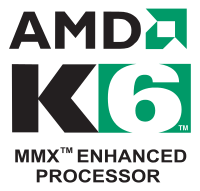From WikiChip
Difference between revisions of "amd/k6"
(Created page with "{{amd title|K6}} {{ic family | title = AMD K6 | image = amd k6 logo.svg | caption = Marketing Logo | developer = AMD | manufacturer...") |
|||
| Line 31: | Line 31: | ||
| successor link = amd/k6-2 | | successor link = amd/k6-2 | ||
}} | }} | ||
| + | '''K6''' was a family of {{arch|32}} [[x86]] microprocessors designed by [[AMD]] and introduced in early 1997 as a successor to their {{amd|K5}} line. K6 lower cost along with superior performance (comparable or better than {{intel|Pentium II}}'s clock-for-clock) made these processors a viable alternative to Intel's. K6 gained wide acceptance in the PC market. | ||
Revision as of 15:45, 26 July 2016
| AMD K6 | |

| |
| Marketing Logo | |
| Developer | AMD |
| Manufacturer | AMD |
| Type | Microprocessors |
| Introduction | April 2, 1997 (launch) |
| Production | 1997 |
| Architecture | Pentium-compatible superscalar microprocessors with MMX |
| ISA | IA-32 |
| µarch | K6 |
| Word size | 32 bit 4 octets
8 nibbles |
| Process | 350 nm 0.35 μm , 250 nm3.5e-4 mm 0.25 μm
2.5e-4 mm |
| Technology | CMOS |
| Clock | 166 MHz-300 MHz |
| Package | SPGA-321 |
| Socket | Socket 7 |
| Succession | |
| ← | → |
| K5 | K6-2 |
K6 was a family of 32-bit x86 microprocessors designed by AMD and introduced in early 1997 as a successor to their K5 line. K6 lower cost along with superior performance (comparable or better than Pentium II's clock-for-clock) made these processors a viable alternative to Intel's. K6 gained wide acceptance in the PC market.
Facts about "K6 - AMD"
| designer | AMD + |
| first launched | April 2, 1997 + |
| full page name | amd/k6 + |
| instance of | microprocessor family + |
| instruction set architecture | IA-32 + |
| main designer | AMD + |
| manufacturer | AMD + |
| microarchitecture | K6 + |
| name | AMD K6 + |
| package | SPGA-321 + |
| process | 350 nm (0.35 μm, 3.5e-4 mm) + and 250 nm (0.25 μm, 2.5e-4 mm) + |
| socket | Socket 7 + |
| technology | CMOS + |
| word size | 32 bit (4 octets, 8 nibbles) + |